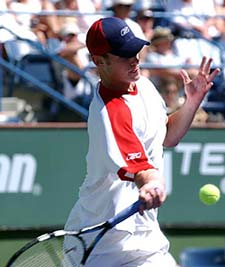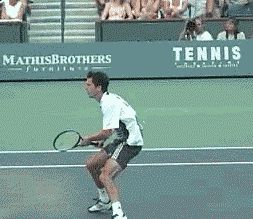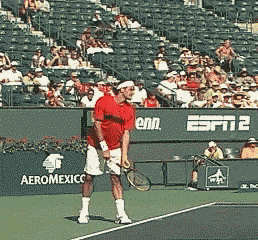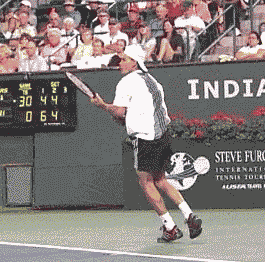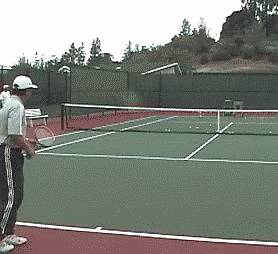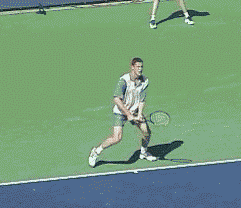|
TennisOne Lessons
First Things First: The Ball by Jim McLennan
If you have worked your way through the First Things First instructional suite - you have gained some perspective about balance and rhythm. You are now more aware of your posture and how that influences vision. You are gaining a greater feel for what your hands either do, or don't do on your initial turn. And you work from the ground (balance) up through your body (posture) and out into the limbs and finally the racquet, all that is left is the ball. In each and every instance the ball has a certain amount of momentum, and moves to us in a specific way. Soft balls, fast balls, skidding balls, ascending balls, descending balls - in every instance there is a way to use what the ball gives us, always with an eye to minimizing effort, always monitoring how the hit feels. Perhaps there are three types of hitters, though any categorization may be an oversimplification. But at our club I see those that "Block," "Swing," and "Whip." Interestingly, the blockers are most adept at the net, as well as finessing angled shots, but these players generally are not the best servers. The swingers have the knack for accelerating the racquet on groundstrokes, and though they may volley or serve reasonably well, they are known for either the forehand or backhand groundstroke.
Finally, the whippers have extremely good serves, but their loose whippy nature interferes with touch at the net and with control off the ground. Said another way, there may actually be three separate hitting skills one has to master, the blocked volley, the free swinging groundstroke, and the whip action serve. But getting back to the ball, there is another way to look at it. In terms of momentum, or rebound potential of the incoming ball, the three skills have quite different balls to work with. At the net the incoming ball has its greatest momentum, blocking makes perfect sense, to make a placement winner requires accuracy rather than power, here one needs only to borrow pace. Groundstrokes meet a ball that has bounced, so it has less energy than one finds when volleying, and in this instance one needs to return the ball a greater distance, so a long but controlled swing fits the bill.
On the serve, however, the ball has little or no rebound energy; the toss descends gently as you make contact, so here great racquet speed is required. On court, your awareness moves from your balance posture and rhythm, to the momentum of the incoming ball. In all cases there is a collision, and one needs only to monitor how each collision feels. Find a way to volley with minimum racquet action, so the heaviness of the racquet matches the incoming momentum of the ball, and the resulting bump is solid but not overdone. On groundstrokes find a way to match the speed of your swing with the incoming momentum of the ball. Generally the errors occur when one over hits the floater, or under hits the drive. Finally, when serving, feel that you must give the ball everything; there is nothing here to work with other than racquet acceleration. Interestingly, working in this area may actually improve your vision. For instead of simply watching the ball, now you are evaluating its incoming speed, looking more closely generally improves your timing. Using Spin
Now consider spin. Categorize three swing paths, low to high, high to low or level. Said another way, up swings, down swings, and level swings. Obviously upswings produce topspin, downswings create backspin, and level swings produce flat hits. Similarly, we can generalize three types of incoming balls at the contact point, ascending balls, descending balls, and balls at the top of the bounce (neither ascending or descending). At a backboard, a descending ball rebounds down, and accumulates slight topspin. At this same backboard, an ascending ball rebounds up and accumulates slight backspin, and a level ball rebounds straight back without accumulating either topspin or backspin. Much like the aikido practitioner who redirects the opponent's energy and perfects moves that use that energy to increase the force of the counter play, a tennis player can do this on court, using what the ball gives us. For example, at the net, a deft drop shot occurs with a subtle down swing placed against an up ball. The up ball produces backspin, the down swing produces backspin, and the up ball rebounds up which nicely counters or balances the down forces in the down swing. Try it, it works.
On the half volley, a level hit actually places the ball up and over the net, because taking the ball on the short hop, the up moving ball rebounds up off the racquet, and all the lift needed for this shot is in the rebound rather than in an up swing. In the backcourt, swinging up at a down ball produces increased topspin. In this case the down ball produces its own topspin, the up swing produces more topspin, and the upswing nicely counteracts the properties of a down bounce. The opposite is all too familiar. Swinging up at an up ball generally sends the ball long, unless one compensates with an extremely closed racquet face. Similarly, swinging down at a down ball is nearly impossible, unless again the racquet face is extremely open. At the extreme of this analysis, a very high service toss (Steffi Graf) actually produces topspin with a flat delivery, for the down momentum were it to occur against a wall would produce significant topspin. Again, reading the movement of the ball as it approaches the contact zone heightens the visual clarity. Now there is really something to look for when someone encourages you (and I hope you are not saying this to yourself) "watch the ball". Practice, Practice, Practice Once you can visualize how the flight of the ball can influence the spin of the shot, the following drills will make sense and improve your feel for backspin and forward spin (I prefer that to topspin).
Using a ball machine, or a practice partner, request (from partner) or create (from machine ) a bit of a high floater bouncing near the service line, where the top of the bounce is at least 7 feet high and where the ball descends before the baseline. Forward spin drill - position yourself where the ball is descending from its peak and you can contact the ball at approximately waist height. From this spot start working on your forward spin stroke. The rapidly descending ball will increase the amount of forward spin, and further your upstroke will be more or less parallel to the descending flight of the ball - and this parallel aspect is good. Backspin drill - request or create a slightly lower trajectory ball bouncing again on the service line, where the top of the bounce is perhaps six feet high. In this instance stand well inside the baseline at a point where the ball is approximately waist height, but in this instance stand where this contact spot is on the ascent of the ball from its bounce, taking it early or on the rise. This rising ball will increase the effects of backspin, and in this instance a down stroke is again more or less parallel with the flight of the ascending ball, again a good thing. Finally move to a spot where you are near the top of the bounce - in this instance the flight of the ball will not create its own spin so your options are to experiment with a flat stroke (again the swing and flight of the ball are more or less parallel) or with backspin and with forward spin. You may note that you create less spin in this situation, and if so then you are getting a hang for how the ball helps you create spin.
Bonus shots - the drop shot is devastating on clay, used frequently in senior tennis (where I prowl) and tellingly was used in the 2001 US Open final where Safin toyed with Sampras. Ssomewhere in the middle of the match - I thought to myself, Safin is drop shotting the greatest player in the game, when have I ever seen such a thing. In any event, the trick (as it was with Marat) is to get this drop shot as the ball is ascending from the bounce, this increases the amount of backspin and also places you closer to the net where the ball will be in the air less long, and taking the ball early adds just the slightest element of surprise. To do this, bevel the racquet face and swing sharply down on the rising ball the look up and see how surprised your opponent is. Your comments are welcome. Let us know what you think about Jim McLennan's article by emailing us here at TennisOne.
|
||||||||||||||

